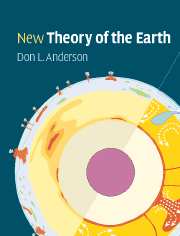Book contents
- Frontmatter
- Contents
- Preface and Philosophy
- Abbreviations and acronyms
- Part I Planetary perspective
- Chapter 1 Origin and early history
- Chapter 2 Comparative planetology
- Chapter 3 The building blocks of planets
- Part II Earth: the dynamic planet
- Part III Radial and lateral structure
- Part IV Sampling the Earth
- Part V Mineral physics
- Part VI Origin and evolution of the layers and blobs
- Part VII Energetics
- References and notes
- Appendix
- Index
Chapter 2 - Comparative planetology
Published online by Cambridge University Press: 05 June 2012
- Frontmatter
- Contents
- Preface and Philosophy
- Abbreviations and acronyms
- Part I Planetary perspective
- Chapter 1 Origin and early history
- Chapter 2 Comparative planetology
- Chapter 3 The building blocks of planets
- Part II Earth: the dynamic planet
- Part III Radial and lateral structure
- Part IV Sampling the Earth
- Part V Mineral physics
- Part VI Origin and evolution of the layers and blobs
- Part VII Energetics
- References and notes
- Appendix
- Index
Summary
The sun, with all those planets revolving around it and dependent on it, can still ripen a bunch of grapes as if it had nothing else in the universe to do.
Galileo GalileiBefore the advent of space exploration, Earth scientists had a handicap almost unique in science: they had only one object to study. Compare this with the number of objects available to astronomers, particle physicists, biologists and sociologists. Earth theories had to be based almost entirely on evidence from Earth itself. Although each object in the solar system is unique, we have learned some lessons that can be applied to Earth.
(1) Study of the Moon, Mars and the basaltic achondrites demonstrated that early melting is ubiquitous.
(2) Although primitive objects, such as the carbonaceous chondrites, have survived for the age of the solar system, there is no evidence for the survival of primitive material once it has been in a planet.
(2) The magma-ocean concept proved useful when applied to the Earth, taking into account the differences required by the higher pressures on the Earth.
(3) The importance of great impacts in the early history of the planets is now clear.
(4) Material was still being added to the Earth and Moon after the major accretion stage and the giant impacts, and is still being added, including material much richer in the noble metals and noble gases than occur in the crust or mantle.
(5) The difference in composition of the atmospheres of the terrestrial planets shows that the original volatile compositions, the extent of outgassing – or the subsequent processes of atmospheric escape – have been quite different.
[…]
- Type
- Chapter
- Information
- New Theory of the Earth , pp. 12 - 21Publisher: Cambridge University PressPrint publication year: 2007
- 2
- Cited by



